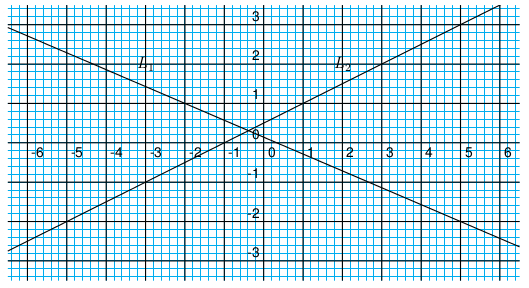2.1 Linear Functions and Straight Lines
What is a linear function?
A linear function is a function whose graph is a straight line.
All linear functions have the form \(f ( x ) = a x + b\) for constants \(a\) and \(b\), where \(a\) is the slope of the line and \((0, b)\) is the \(\mathbf{y}\)-intercept of the line--the point where the line crosses the \(y\)-axis.
From the fact that two points determine a line it follows that the equation of a linear function can be determined from knowing the output values corresponding to any two input values.
For example, suppose that we know that \(f\) is a linear function and we know that \(f (1) = - 2\) and that \(f (4) = 3\).
Then it follows that the points \((1,- 2)\) and \((4,3)\) lie on the graph of the function.
We compute the slope \(a\) of the line by dividing the difference of the outputs by the difference of the inputs, getting the result \(a=\dfrac{5}{3}\).
To discover the value of \(b\), we note that \(f ( x ) = \dfrac{3-(-2))}{4-1}=\dfrac{5}{3} x + b\).
Thus, when \(x = 1\), \(f ( 1 ) = \dfrac{5}{3}\cdot1 + b\).
So \(- 2 = \dfrac{5}{3} + b\). Solving this for \(b\) gives \(b = - \dfrac{11}{3}\).
Thus, the equation of the function is \(f ( x ) = \dfrac{5}{3} x - \dfrac{11}{3}\).The correctness of this result is easily verified by seeing that it indeed gives the correct results \(f (1) = - 2\) and \(f (4) = 3\).
Exercise 2.1.1
The function \(T\) which converts degrees Fahrenheit to degrees Celsius is a linear function. Given that \(T( 32 ) = 0\) and \(T( 98.6 ) = 37\), find the equation of the function.
See SolutionFinding the slope of a line.
It is more common to use the letter \(m\) rather than the letter \(a\) to denote the slope of a line. In the exammple above we found the slope of a linear function by dividing the difference of two outputs by the difference of the corresponding inputs. In general, if we know the coordinates of two points on the line, let us say \((x_1,y_1)\) and \((x_2,y_2)\), then the formula for the slope \(m\) is
\[m=\frac{y_2-y_1}{x_2-x_1}\]
For example, suppose that a line \(L\) contains the points \((-5,3)\) and \((2,1)\). Then the slope of \(L\) will be \(m=\dfrac{1-3}{2-(-5)}=-\dfrac{2}{7}\).Exercise 2.1.2
Find the slope of the line containing the points \((-3,5)\) and \((0,7)\).
See SolutionEquations of lines
There are several different equations of lines. There is the slope-intercept equation of a line. It is called this since the slope \(m\) is the coefficient of \(x\) and the constant term of the equation is the \(y\)-intercept \(b\).
\[y=mx+b\]
Another equation for a line is the point-slope equation. If the slope \(m\) is known and if the coordinates \((x_1,y_1)\) of a point on the line are known, then
\[y-y_1=m(x-x_1)\]
If a line has a non-zero \(x\)-intercept \(a\) and a non-zero \(y\)-intercept \(b\), then the intercept equation for the line is
\[\frac{x}{a}+\frac{y}{b}=1\]
The equation of a horizontal line with \(y\)-intercept \(b\) is
\[y=b\]
The equation of a vertical line with \(x\)-intercept \(a\) contains no \(y\) variable at all. The equation of the vertical line is
\[x=a\]
None of the equations mentioned so far is sufficiently general to accommodate both vertical and non-vertical lines. In order to accommodate both vertical and non-vertical lines we need one of two versions of the general equation of a line. One version of the general equation is
\[Ax+By=C\]
Another version of the general equation of a line is
\[Ax+By+C=0\]
Exercise 2.1.3
Find the point-slope equation of the line with slope \(-2\) and \(y\)-intercept \(5\).
See SolutionExercise 2.1.4
Find the point-slope and the slope-intercept equation of the line with slope \(3\) containing the point \((2,-3)\).
See SolutionExercise 2.1.5
Find the intercept equation and the point-slope equation of the line which crosses the \(x\)-axis at \((3,0)\) and crosses the \(y\)-axis at \((0,2)\).
See SolutionExercise 2.1.6
Find the equation of the horizontal line which contains the point \((5,-3)\).
See SolutionExercise 2.1.8
Re-write the equation \(y=\dfrac{2}{3}x-\dfrac{3}{4}\) in general form (both versions) with \(A\) positive and with integer, not fraction values for \(A\), \(B\) and \(C\).
See SolutionParallel and perpendicular lines
Given lines \(L_1\) and \(L_2\) with slopes \(m_1\) and \(m_2\), respectively then if \(L_1\) and \(L_2\) are parallel they have the same slope \(m_1=m_2\). But if \(L_1\) and \(L_2\) are perpendicular, then \(m_1m_2=-1\), or, put another way, \(m_2=-\dfrac{1}{m_1}\).
Exercise 2.1.9
Suppose line \(L_1\) has equation \(2x+3y=6\). Find the slope of \(L_1\).
Suppose line \(L_2\) is parallel to line \(L_1\) and contains the point \((2,-1)\) and line \(L_3\) is perpendicular to line \(L_1\) and contains the point \((2,-1)\). Find the slopes \(m_2\) and \(m_3\) of lines \(L_2\) and \(L_3\).
Find the point-slope equations and the general equations of lines \(L_2\) and \(L_3\). Use the \(Ax+By=C\) version of the general equation with \(A\) positive and with \(A\), \(B\) and \(C\) integers rather than fractions.
Graph all three equations. Graph Paper
See Solution